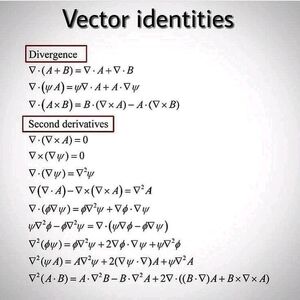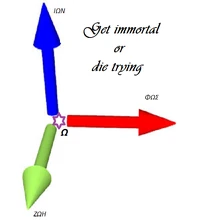Τελεστής Ανάδελτα
Nabla Del, Nabla, Αναδελτικός Τελεστής

Εφαπτομένη
Εφαπτόμενο Διάνυσμα
Εφαπτομενικός Χώρος
Διαφορικός Τελεστής
Παράγωγος
Διαφορική Γεωμετρία




Στην Διαφορική Ανάλυση, το "ανάδελτα" είναι ένας διανυσματικός, διαφορικός τελεστής.
Ορισμοί[]
Σε ένα τρισδιάστατο Καρτεσιανό Σύστημα Συντεταγμένων (Cartesian coordinate system) ενός Ευκλείδειου Χώρου R3 με συνταταγμένες (x, y, z), ο τελεστής "ανάδελτα" μπορεί να ορισθεί ως εξής:
ή εναλλακτικά,
- όπου:
είναι η πρότυπη βάση (standard basis) στον χώρο R3.
In vector calculus, del is a vector differential operator, usually represented by the nabla symbol . - When applied to a function defined on a one-dimensional domain, it denotes its standard derivative as defined in calculus. - When applied to a field (a function defined on a multi-dimensional domain), del may denote the gradient (locally steepest slope) of a scalar field, the divergence of a vector field, or the curl (rotation) of a vector field, depending on the way it is applied.
Strictly speaking, del is not a specific operator, but rather a convenient mathematical notation for those three operators, that makes many equations easier to write and remember. The del symbol can be interpreted as a vector of partial derivative operators, and its three possible meanings—gradient, divergence, and curl—can be formally viewed as the product of scalars, dot product, and cross product, respectively, of the del "operator" with the field. These formal products may not commute with other operators or products.
Definition[]
In the three-dimensional Cartesian coordinate system R3 with coordinates (x, y, z), del is defined in terms of partial derivative operators as
where are the unit vectors in their respective directions. Though this page chiefly treats del in three dimensions, this definition can be generalized to the n-dimensional Euclidean space Rn. In the Cartesian coordinate system with coordinates (x1, x2, ..., xn), del is:
where is the standard basis in this space.
More compactly, using the Einstein summation notation, del is written as
Del can also be expressed in other coordinate systems, see for example del in cylindrical and spherical coordinates.
Notational uses[]
Del is used as a shorthand form to simplify many long mathematical expressions. It is most commonly used to simplify expressions for the gradient, divergence, curl, directional derivative, and Laplacian.
Gradient[]
The vector derivative of a scalar field f is called the gradient, and it can be represented as:
It always points in the direction of greatest increase of f, and it has a magnitude equal to the maximum rate of increase at the point—just like a standard derivative. In particular, if a hill is defined as a height function over a plane h(x,y), the 2d projection of the gradient at a given location will be a vector in the xy-plane (sort of like an arrow on a map) pointing along the steepest direction. The magnitude of the gradient is the value of this steepest slope.
In particular, this notation is powerful because the gradient product rule looks very similar to the 1d-derivative case:
However, the rules for dot products do not turn out to be simple, as illustrated by:
Divergence[]
The divergence of a vector field is a scalar function that can be represented as:
The divergence is roughly a measure of a vector field's increase in the direction it points; but more accurately, it is a measure of that field's tendency to converge toward or repel from a point.
The power of the del notation is shown by the following product rule:
The formula for the vector product is slightly less intuitive, because this product is not commutative:
Curl[]
The curl of a vector field is a vector function that can be represented as:
The curl at a point is proportional to the on-axis torque to which a tiny pinwheel would be subjected if it were centered at that point.
The vector product operation can be visualized as a pseudo-determinant:
Again the power of the notation is shown by the product rule:
Unfortunately the rule for the vector product does not turn out to be simple:
Directional derivative[]
The directional derivative of a scalar field f(x,y,z) in the direction is defined as:
This gives the change of a field f in the direction of a. In operator notation, the element in parentheses can be considered a single coherent unit; fluid dynamics uses this convention extensively, terming it the convective derivative—the "moving" derivative of the fluid.
Laplacian[]
The Laplace operator is a scalar operator that can be applied to either vector or scalar fields; it is defined as:
The Laplacian is ubiquitous throughout modern mathematical physics, appearing in Laplace's equation, Poisson's equation, the heat equation, the wave equation, and the Schrödinger equation—to name a few.
Tensor derivative[]
Del can also be applied to a vector field with the result being a tensor. The tensor derivative of a vector field is a 9-term second-rank tensor, but can be denoted simply as , where represents the dyadic product. This quantity is equivalent to the Jacobian matrix of the vector field with respect to space.
Second derivatives[]
DCG chart: A simple chart depicting all rules pertaining to second derivatives. D, C, G, L and CC stand for divergence, curl, gradient, Laplacian and curl of curl, respectively. Arrows indicate existence of second derivatives. Blue circle in the middle represents curl of curl, whereas the other two red circles(dashed) mean that DD and GG do not exist.
When del operates on a scalar or vector, generally a scalar or vector is returned. Because of the diversity of vector products (scalar, dot, cross) one application of del already gives rise to three major derivatives: the gradient (scalar product), divergence (dot product), and curl (cross product). Applying these three sorts of derivatives again to each other gives five possible second derivatives, for a scalar field f or a vector field v; the use of the scalar Laplacian and vector Laplacian gives two more:
These are of interest principally because they are not always unique or independent of each other. As long as the functions are well-behaved, two of them are always zero:
Two of them are always equal:
The 3 remaining vector derivatives are related by the equation:
And one of them can even be expressed with the tensor product, if the functions are well-behaved:
Precautions[]
Most of the above vector properties (except for those that rely explicitly on del's differential properties—for example, the product rule) rely only on symbol rearrangement, and must necessarily hold if del is replaced by any other vector. This is part of the tremendous value gained in representing this operator as a vector in its own right.
Though you can often replace del with a vector and obtain a vector identity, making those identities intuitive, the reverse is not necessarily reliable, because del does not often commute.
A counterexample that relies on del's failure to commute:
A counterexample that relies on del's differential properties:
Central to these distinctions is the fact that del is not simply a vector; it is a vector operator. Whereas a vector is an object with both a precise numerical magnitude and direction, del does not have a precise value for either until it is allowed to operate on something.
For that reason, identities involving del must be derived with care, using both vector identities and differentiation identities such as the product rule.
Υποσημειώσεις[]
Εσωτερική Αρθρογραφία[]
- Αναδελτική Αναπαράσταση
- Πίνακας Μαθηματικών Συμβόλων
- Εξισώσεις Maxwell
- Ανάδελτα σε Πολικό Σύστημα
Βιβλιογραφία[]
- Div, Grad, Curl, and All That, H. M. Schey, ISBN 0-393-96997-5
- Jeff Miller, Earliest Uses of Symbols of Calculus (Aug. 30, 2004).
- Cleve Moler, ed., "History of Nabla", NA Digest 98 (Jan. 26, 1998).
Ιστογραφία[]
- Ομώνυμο άρθρο στην Βικιπαίδεια
- Ομώνυμο άρθρο στην Livepedia
- A survey of the improper use of ∇ in vector analysis (1994) Tai, Chen
- A survey of the improper use of ∇ in vector analysis (1994) Tai, Chen
|
Αν και θα βρείτε εξακριβωμένες πληροφορίες "Οι πληροφορίες αυτές μπορεί πρόσφατα Πρέπει να λάβετε υπ' όψη ότι Επίσης, |
- Μην κάνετε χρήση του περιεχομένου της παρούσας εγκυκλοπαίδειας
αν διαφωνείτε με όσα αναγράφονται σε αυτήν
- Όχι, στις διαφημίσεις που περιέχουν απαράδεκτο περιεχόμενο (άσεμνες εικόνες, ροζ αγγελίες κλπ.)


















![{\displaystyle \nabla \times {\vec {v}}=\left|{\begin{matrix}\mathbf {\hat {x}} &\mathbf {\hat {y}} &\mathbf {\hat {z}} \\[2pt]{\frac {\partial }{\partial x}}&{\frac {\partial }{\partial y}}&{\frac {\partial }{\partial z}}\\[2pt]v_{x}&v_{y}&v_{z}\end{matrix}}\right|}](https://services.fandom.com/mathoid-facade/v1/media/math/render/svg/2b507c5e3e8ad50db8eb1cc1633d14adeccb32f7)






























